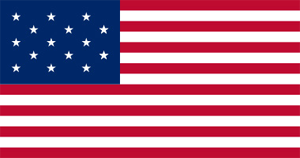War of 1812 Battles |
Colonial Wars |
American Wars |
Battle of Craney Island
June 22, 1813 at Craney Island, Virginia
 |
|||||||||||||||||||
|
The battle of Craney Island saved the city of Norfolk, Virginia from British invasion.
Adm. Sir George Cockburn commanded an impressive British fleet blockading Chesapeake Bay. In early 1813, Adm. George Cockburn and Adm. Sir John Borlase Warren planned an attack on Norfolk. The key to the defense of Norfolk was Craney Island. This island was located close to shore with a bridge that linked it to the mainland. The objective of this attack was to capture the American frigate USS Constellation and destroy the shipyard.
On June 20, a British naval force of 3 ships with 74 guns, one ship with 64 guns, 4 frigates, 2 sloops and 3 transports anchored off Craney Island.
Brig. Gen. Robert B. Taylor commanded the Virginia Militia in the Norfolk area. Taylor hastily built defenses around Norfolk and Portsmouth, but had no intentions of letting the British penetrate as far as those two cities. Instead Taylor commandeered several ships and created a barrier across the Elizabeth River. He next built fortifications on Craney Island at the mouth of the Elizabeth River near Hampton Roads.
Since the Constellation was already penned up in the Chesapeake due to the British blockade, the ship's crew was used to man some of the redoubts on the island. On the north-west side of this island was a battery of 18 pounders, which Capt. Cassin, commanding the American naval forces at Norfolk assigned 100 sailors from the "Constellation". These men were commanded by Lt. Neale, Lt. Shubrick, and Lt. Saunders. Also, 50 marines were sent to defend the island under the command of Lt. Breckenbridge, 150 American defenders in all.
Warren ordered Capt. Pechell of the ship San Domingo to lead the attack over the objections of Cockburn who had recommended Lt. Westphal.
On June 22, a British force of 15 boats, containing seamen, marines, chasseurs and soldiers of the 102nd regiment, some 700 men in all made their way for Craney Island.
When the British landed, the Americans realized they were not flying a flag and quickly raised an American flag over the breastworks. They fired with deadly accuracy and the British began to fall back. A second attack was made against the eastern side of the fort. Defending this portion was a company of light artillery under the command of Capt. Arthur Emmerson. Emmerson ordered his gunners to hold their fire until the British were in range. When they opened fire, it had a devastating effect. Approximately 70 yards from the guns, one of the British boats grounded on a shoal, and the attack was checked. Three boats had been sunk by American artillery fire from the island, but the water was so shallow they were still above water. Crew members from the Constellation waded out and took possession of the British boats. The British then retreated in disorder, having lost 91 men and 3 boats.
The Americans had scored a decisive victory in the face of superior forces. Norfolk and the shipyards were spared from attack. The British suffered greatly compared to the defenders, roughly 200 of the British were lost in the attacks, while there were no American casualties. Having failed in their efforts against Norfolk, Cockburn moved to the shipyards at St. Michaels, Maryland.
